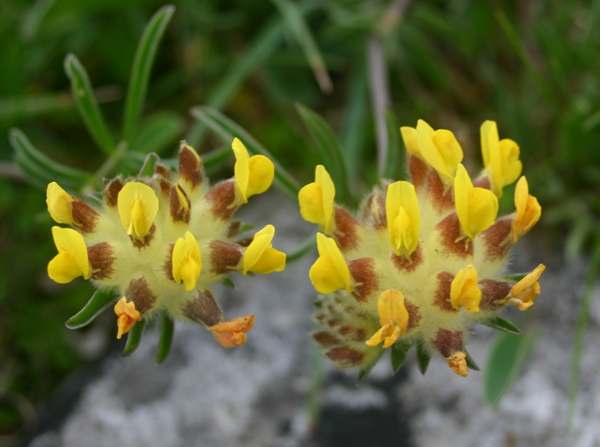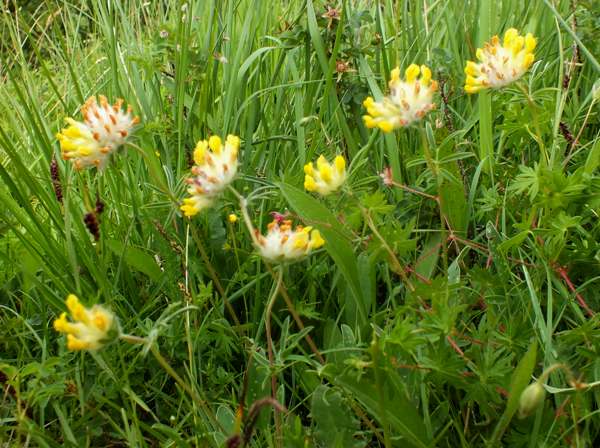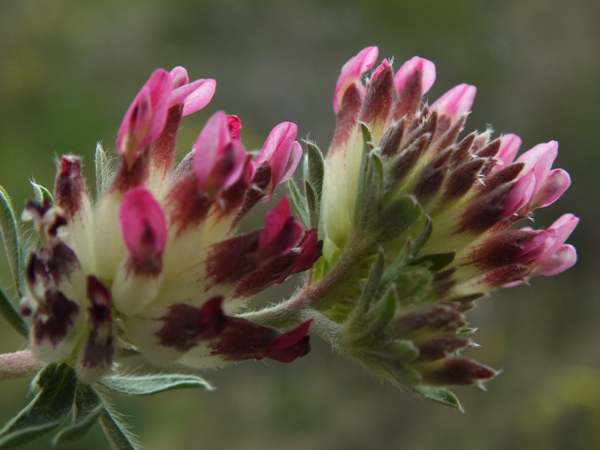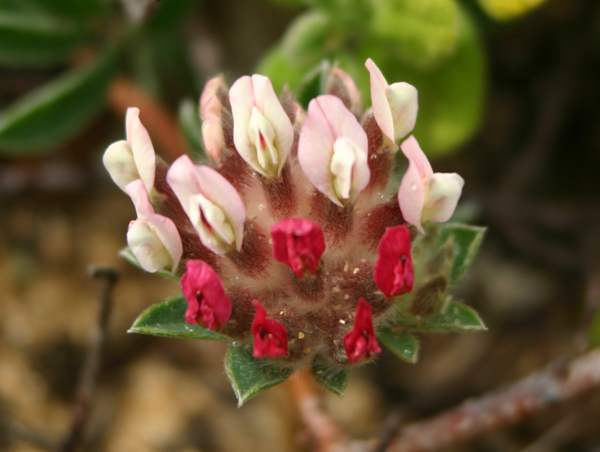Trees Birds Mammals Fish Amphibians Reptiles
Wild Algarve
Bookshop
Anthyllis vulneraria - Kidney Vetch
Phylum: Magnoliophyta - Class: Equisetopsida - Order: Fabales - Family: Fabaceae

This generally low-growing member of the pea family (fabaceae, formerly referred to as the legiminosae) has unusual flower heads; they are in two parts. One side will be coming into bloom while the other has semi-ripened seeds.
Description
Occasionally reaching a height of 25cm but more often nearly prostrate and no more than 15cm tall, Kidney Vetch usually has branching ascending stems topped by a distinctive loose clover-like inflorescence. In the wild, the petals of Kidney Vetch usually range from yellow through to orange; they are pink in the case of Anthyllis vulneraria var. coccinea. Cultivars have been produced which have deep red flowers.

The leaves have a few scattered hairs on their upper surfaces and silky hairs on the underside.

Pink-flowered Kidney Vetch found in the Ardeche region of soutern France
Distribution
Anthyllis vulneraria is common and widespread in Britain and Ireland; it occurs also throughout mainland Europe. Kidney Vetch is a particularly common plant in the Mediterranean region, where the pink-flowered form is more often seen. Plants seen in Slovenia are generally a paler, lemon yellow than the ones we see in Britain.

Habitat
Kidney Vetch copes well with dry conditions and is commonly seen on the edges of sandy coastal footpaths as well as in sand-dune systems. Dry grassland and calcareous rocky areas, including roadside verges where lime chippings have been spread, are also favoured by this drought-tolerant plant.
Blooming Times
In Northern Europe, Kidney Vetch blooms between April and September. Further south in the Mediterranean region the flowers appear much earlier in the year, but they are usually over by the end of May.
Etymology
Anthyllis, the genus name, comes from the Greek words anthos- meaning flower, and -ioulos meaning downy (as are the undersides of leaves).
The specific epithet vulneraria means 'healer of wounds' - a reflection of past medicinal uses of this plant.
The yellow Kidney Vetch flowers shown on this page were seen growing on coastal cliffs in Pembrokeshire, West Wales, in July, while the pink specimen was photographed in southern France in April.
Sue Parker's latest ebook is a revised and enlarged edition of Wild Orchids in The Burren. Full details here...
Buy it for just £5.95 on Amazon...
Sue Parker's new ebook is a comprehensive and fully revised edition of her acclaimed field guide to the Wild Orchids of Wales. Full details here...
Buy it for just £5.95 on Amazon...
Please Help Us: If you have found this information interesting and useful, please consider helping to keep First Nature online by making a small donation towards the web hosting and internet costs.
Any donations over and above the essential running costs will help support the conservation work of Plantlife, the Rivers Trust and charitable botanic gardens - as do author royalties and publisher proceeds from books by Pat and Sue.